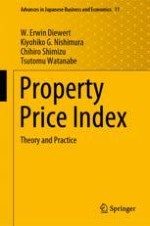2020 | OriginalPaper | Chapter
4. Estimation of Residential Property Price Index: Methodology and Data Sources
Authors : W. Erwin Diewert, Kiyohiko G. Nishimura, Chihiro Shimizu, Tsutomu Watanabe
Published in: Property Price Index
Publisher: Springer Japan
Activate our intelligent search to find suitable subject content or patents.
Select sections of text to find matching patents with Artificial Intelligence. powered by
Select sections of text to find additional relevant content using AI-assisted search. powered by
